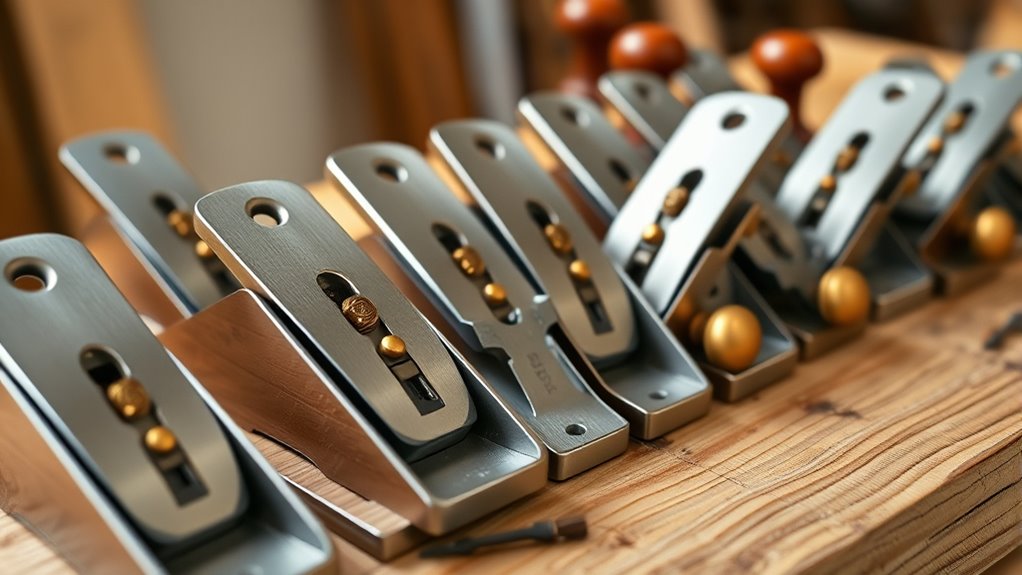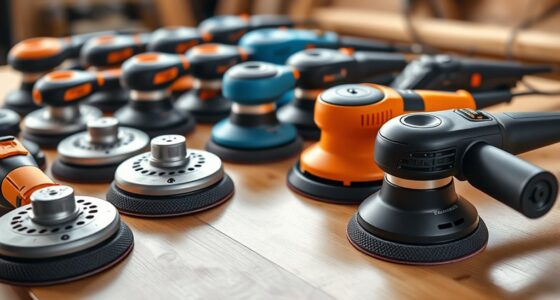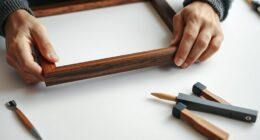If you’re looking to sharpen your woodworking skills in 2025, I’ve found some of the best block planes that offer precision, control, and durability. From compact miniatures like the Jorgensen 3.5 Mini to versatile models like the Spear & Jackson CBP95, these tools are built with quality materials and easy adjustments. Whether for fine detail or general trimming, these options can help you achieve professional results. Keep exploring, and you’ll discover even more tools suited for your projects.
Key Takeaways
- Focus on models with fine adjustment controls for precise blade setting and smooth tuning.
- Prioritize planes made from durable materials like cast iron, high-carbon steel, or ductile iron for longevity.
- Consider sizes and designs that offer ergonomic handling, lightweight construction, and easy portability.
- Look for versatile planes with interchangeable blades or adjustable mouths suitable for different woodworking tasks.
- Balance cost and quality, selecting options that provide precision, durability, and ease of maintenance for 2025.
Jorgensen No.60-1/2 6-1/4 Wood Planer, Mini Hand Planer
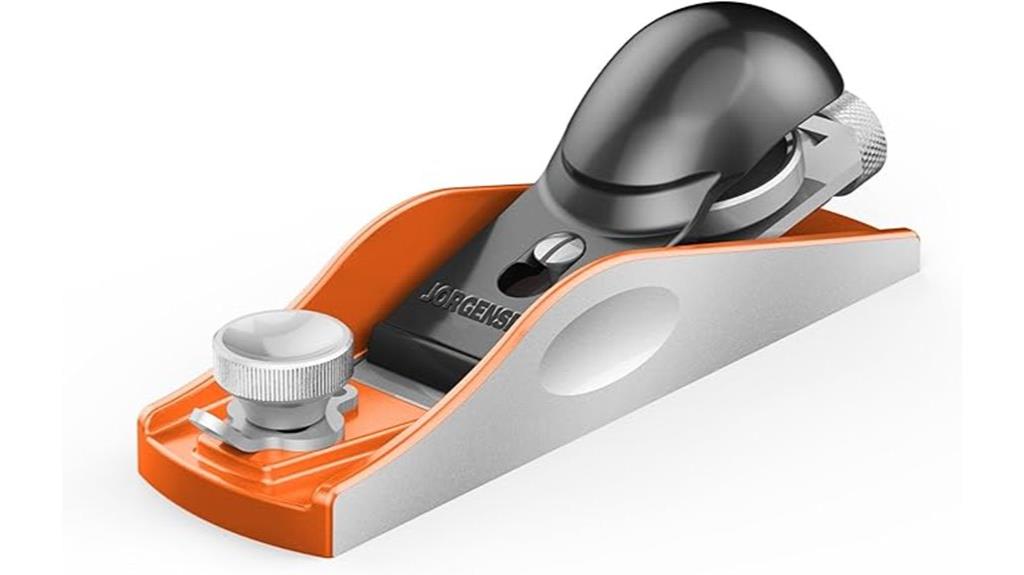
If you’re looking for a compact, precise tool for detailed woodworking tasks, the Jorgensen No.60-1/2 6-1/4 Wood Planer is an excellent choice. Its small size makes it perfect for trimming, polishing, and deburring, especially in tight spots. The polished flat bottom guarantees smooth operation, while adjustable mouth and cutting depth let me customize each project. Made of durable ductile iron and stainless steel, it withstands heavy use. The sharp, professional-grade blade cuts efficiently and can be sharpened repeatedly. Easy to handle, it’s ideal for both beginners and pros who need precise surface finishing on various wood projects.
Best For: DIY enthusiasts, woodworking hobbyists, and professionals needing precise, portable planing for detailed wood finishing tasks.
Pros:
- Compact and lightweight design for easy handling and maneuverability
- Adjustable cutting depth and mouth for customized planing projects
- Durable construction with high-quality materials ensuring long-lasting performance
Cons:
- Limited blade size may not be suitable for large surface planing tasks
- Requires manual sharpening of the blade for optimal performance over time
- May have a steeper learning curve for complete beginners unfamiliar with hand planers
JORGENSEN 3.5 Mini Wood Planer
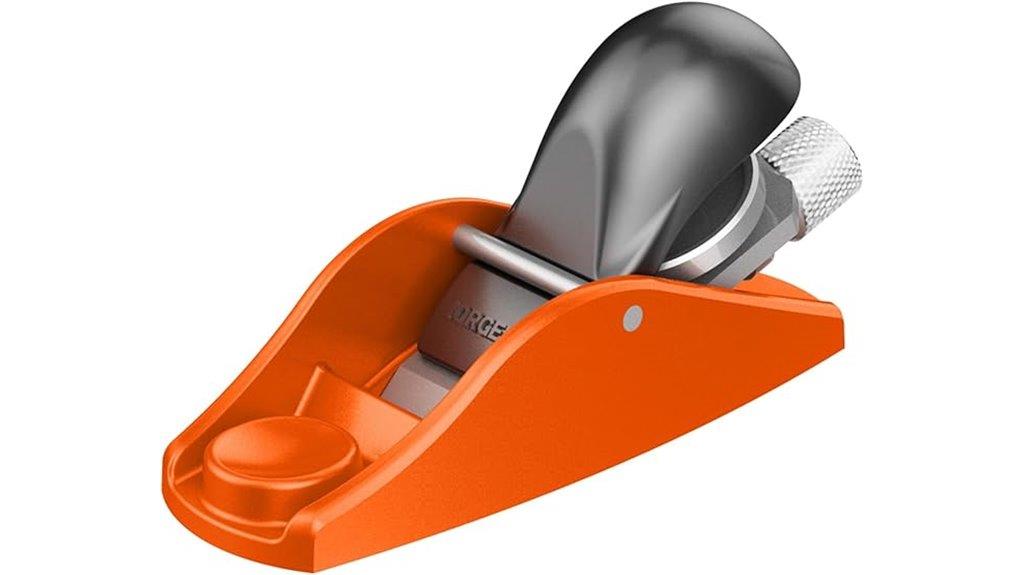
The Jorgensen 3.5 Mini Wood Planer stands out for its compact size and precision, making it an ideal choice for detailed woodworking tasks and small projects. Its 3.5-inch length and lightweight design (just 8.8 ounces) enable easy handling and control, perfect for trimming, polishing, or surface finishing. Built with a durable ductile iron body and stainless steel parts, it offers long-lasting performance. The sharp O1 tool steel blade can be micro-adjusted for precise depth control, ensuring smooth, accurate cuts. Many users appreciate its versatility, ease of use, and affordability, making it a favorite for detailed craft work and small-scale projects.
Best For: hobbyists, DIY enthusiasts, and small woodworking projects requiring precise trimming, polishing, or surface finishing tasks.
Pros:
- Compact and lightweight design for easy handling and maneuverability
- Durable construction with ductile iron body and stainless steel parts
- Micro-adjustable blade for precise depth control and smooth cuts
Cons:
- Limited width (3.5 inches) may restrict use on larger surfaces
- Small size requires careful handling for detailed work
- Not suitable for heavy-duty or large-scale woodworking tasks
Spear & Jackson CBP95 9 1/2 Carpenters Block Plane
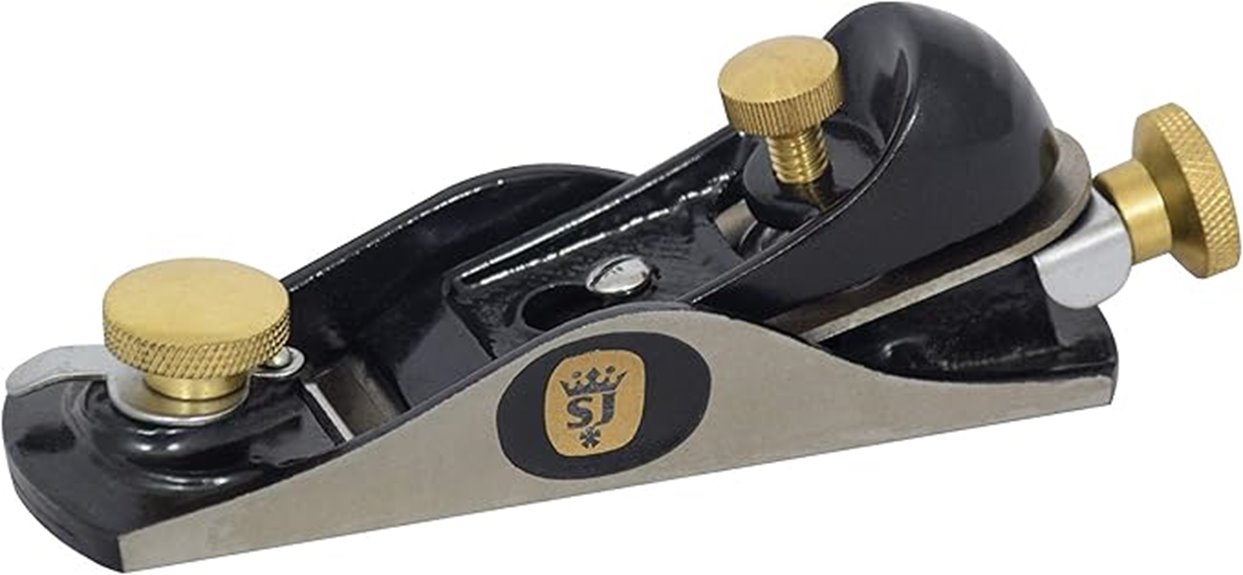
The Spear & Jackson CBP95 9 ½ Carpenters Block Plane stands out as a versatile choice for hobbyists and casual woodworkers who need a compact, hand-operated tool for detailed tasks. Its cast iron body, precision milled base, and adjustable mouth allow for clean, controlled cuts, especially on end grain or fitting doors. Although initial setup requires sanding and tuning due to factory imperfections, once optimized, it performs well on hardwoods like walnut and pine. Weighing just under 2 pounds, it’s ideal for small projects, offering good value despite some quality control concerns. Proper preparation is key to revealing its full potential.
Best For: hobbyists and casual woodworkers seeking a compact, adjustable hand plane for detailed end grain work and small projects.
Pros:
- Easy to adjust and operate with smooth cutting action
- Compact size and lightweight design ideal for small tasks
- Adjustable mouth and precision milled base for controlled cuts
Cons:
- Requires extensive tuning and sanding due to factory imperfections
- Blade steel is soft, leading to dulling and chipping quickly
- Quality control issues such as rough machining and loose parts
Amazon Basics Woodworking Hand Planer (No.4)

Designed for DIYers and hobbyists seeking a budget-friendly yet reliable tool, the Amazon Basics Woodworking Hand Planer No.4 offers impressive performance for its price. Made with a sturdy cast iron body, it provides stability and durability during use. The impact-resistant plastic handle with a contoured grip guarantees comfort and control. Its sharp steel alloy blade handles smoothing, leveling, and minor adjustments efficiently. While setup can be a bit tricky, once calibrated, it cuts smoothly and effectively. At under $18, it’s a great value for light-duty tasks, making it ideal for casual woodworking projects, household repairs, or hobbyist use.
Best For: DIYers and hobbyists seeking a budget-friendly, reliable hand planer for light woodworking tasks and minor surface adjustments.
Pros:
- Sturdy cast iron body offers excellent stability and durability
- Sharp steel alloy blade provides smooth, efficient cuts
- Affordable price under $18 with high user ratings
Cons:
- Adjustment mechanisms can be loose or fiddly to calibrate
- Sole may require flattening or polishing for optimal performance
- Handle design may be uncomfortable for prolonged use
Woodriver Low Angle Block Plane With Adjustable Mouth

If you’re looking for a block plane that offers exceptional control and fine-tuning, the Woodriver Low Angle Block Plane with Adjustable Mouth stands out. Inspired by classic Stanley designs, it features a chrome-plated knuckle cap, a 12° bed angle, and an adjustable mouth for precise shavings. Made from durable ductile iron with a high-carbon steel blade, it’s built for stability and sharpness. The plane’s adjustable mouth lets you fine-tune for different tasks, and the easy blade adjustment ensures smooth operation. With positive user feedback, this plane delivers accurate cuts on both long and end grain, making it a versatile choice for precise woodworking.
Best For: woodworkers seeking precise control and fine-tuning capabilities in a low-angle block plane for detailed and versatile woodworking tasks.
Pros:
- Adjustable mouth allows for fine tuning of shaving thickness, suitable for various materials and tasks
- Durable construction with ductile iron and high-carbon steel blade ensures long-lasting performance
- Classic design inspired by Stanley, offering reliable and proven functionality
Cons:
- Some users experience blade rusting or difficulty maintaining optimal sharpness without additional sharpening
- The knuckle cap may open during use, potentially affecting safety and performance
- Adjustment mechanisms may require frequent minor tuning to maintain optimal operation
WORKPRO Block Plane (W052002)

For woodworkers seeking an affordable yet reliable hand plane, the WORKPRO Block Plane (W052002) offers an excellent balance of functionality and value. Its cast iron body provides durability and stability, while the adjustable cutting depth allows for precise control. The steel blade, set at a shallow angle, easily slices through end grain and performs tasks like chamfering, paring, and touchups. Weighing just 1.54 pounds, it’s lightweight and easy to maneuver. Customers appreciate its effectiveness on softwoods, though some note adjustment can be tricky. Overall, it’s a solid choice for small projects, finishing work, and DIYers needing a dependable, budget-friendly block plane.
Best For: DIY enthusiasts and small-scale woodworkers seeking an affordable, reliable hand plane for detailed finishing, chamfering, and touch-up work on softwoods.
Pros:
- Durable cast iron body ensures stability and longevity.
- Adjustable cutting depth allows for precise control over shaving thickness.
- Lightweight design (1.54 pounds) makes it easy to maneuver and handle.
Cons:
- Some units may have difficulty with blade adjustment or require tuning.
- Quality inconsistencies reported, including cracked front knobs.
- Limited to small projects and softwoods; may not handle heavy-duty tasks.
KAKURI Japanese Hand Plane for Woodworking

The KAKURI Japanese Hand Plane stands out for its traditional craftsmanship and precise control, making it an ideal choice for woodworkers who value fine detail and craftsmanship. Its compact, lightweight design, made from eco-friendly Japanese oak, offers excellent durability and handling. Equipped with a high-carbon steel blade, it delivers a clean, smooth finish on both soft and hard woods. Its pull-style operation allows for greater control, especially on intricate tasks like chamfering and end grain. Easy to set up and hone, this plane is perfect for hobbyists and professionals seeking an authentic, high-quality tool that enhances precision and craftsmanship.
Best For: hobbyists and professional woodworkers seeking a traditional, precise hand plane for detailed smoothing, chamfering, and end grain work.
Pros:
- Crafted from durable, eco-friendly Japanese oak with a high-carbon steel blade for sharp, clean cuts.
- Lightweight and ergonomically designed for comfortable, controlled pulling operation.
- Easy to set up, hone, and use, making it suitable for both beginners and experienced craftsmen.
Cons:
- The cap iron may be flimsy initially and require careful handling or reinforcement over time.
- May have a slight learning curve for those unfamiliar with pull-style Japanese planes.
- Slightly smaller size may limit use on larger, broad surfaces or heavy-duty tasks.
JORGENSEN Chamfer Plane for Woodworking
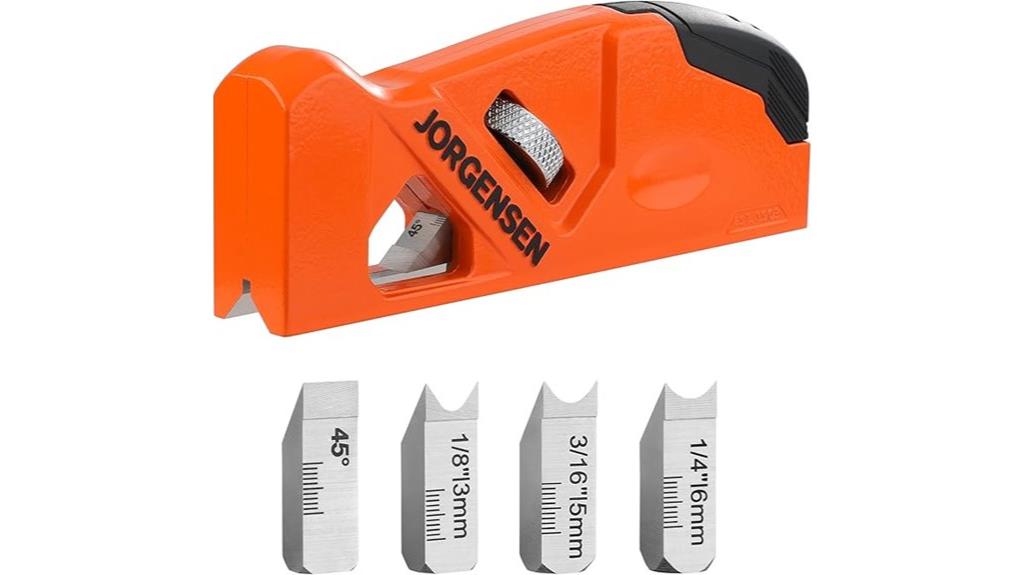
The JORGENSEN Chamfer Plane stands out for its high precision and versatility, making it ideal for professional woodworkers and serious hobbyists seeking clean, accurate edge shaping. Made of durable aluminum, it’s lightweight and comfortable, with an ergonomic curved exterior and grip groove that reduce fatigue. The polished flat bottom guarantees smooth operation without marking the wood. It features four interchangeable cutter heads—45°, 1/4 round, 1/8 round, and 3/16 round—crafted from high-quality steel for sharpness and minimal wear. Adjustable for depth, it’s easy to use but may require some fine-tuning, especially on dense hardwoods.
Best For: professional woodworkers and serious hobbyists seeking precise, versatile edge shaping with a durable, ergonomic tool.
Pros:
- Durable aluminum construction ensures longevity and lightweight handling
- Four interchangeable cutter heads provide versatile edge profiles
- Ergonomic design with curved exterior and grip groove reduces hand fatigue
Cons:
- May require fine-tuning when used on dense hardwoods
- Initial blade setup might need adjustment for optimal performance
- Slight difficulty applying excessive pressure without causing gouges
Spear & Jackson CSP4 No. 4 Smoothing Plane
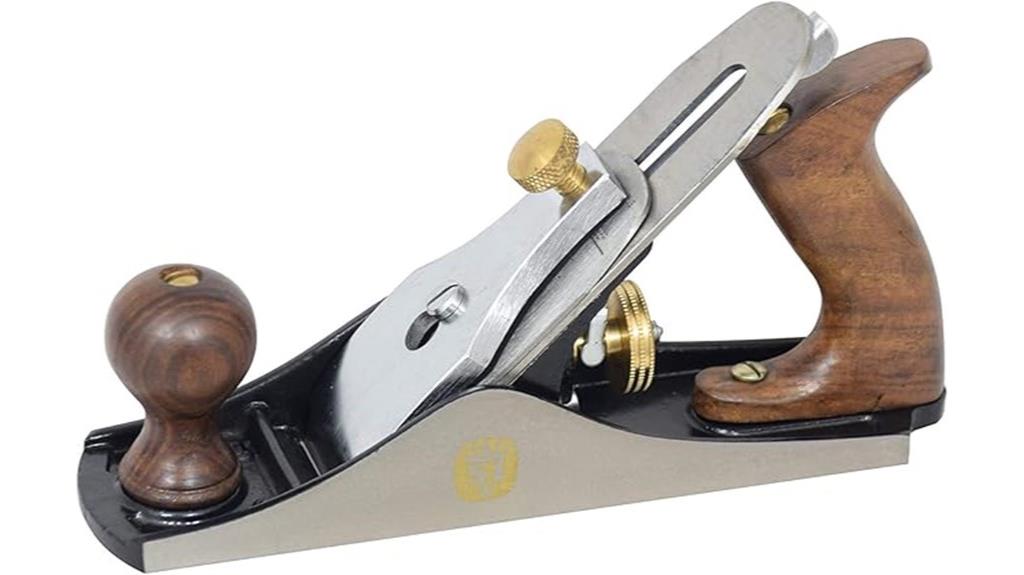
If you’re seeking an affordable, entry-level smoothing plane that delivers solid performance after some tuning, the Spear & Jackson CSP4 No. 4 is a compelling choice. Made with a cast iron body, it’s sturdy and durable, though it benefits from minor flattening and sharpening. The 50mm high carbon steel blade produces fine shavings and smooth finishes once properly tuned. It’s heavy and well-built, but the blade and chip breaker quality could be better, often requiring replacement. With a bit of effort, this plane offers excellent value for beginners or hobbyists looking for a reliable, budget-friendly tool that can be improved over time.
Best For: hobbyists and beginners seeking an affordable, entry-level smoothing plane that can be tuned for better performance.
Pros:
- Made with a sturdy cast iron body for durability.
- Produces fine shavings and smooth finishes after proper tuning.
- Lightweight enough for comfortable handling during extended use.
Cons:
- Blade and chip breaker quality are subpar and may require replacement.
- Initial setup involves flattening sole and blade, sharpening, and tuning.
- Some components, like the adjustment wheel and threads, may be loose or poorly machined.
FIRSTINFO H5401 Mini Hand Plane for Woodworking and Trimming
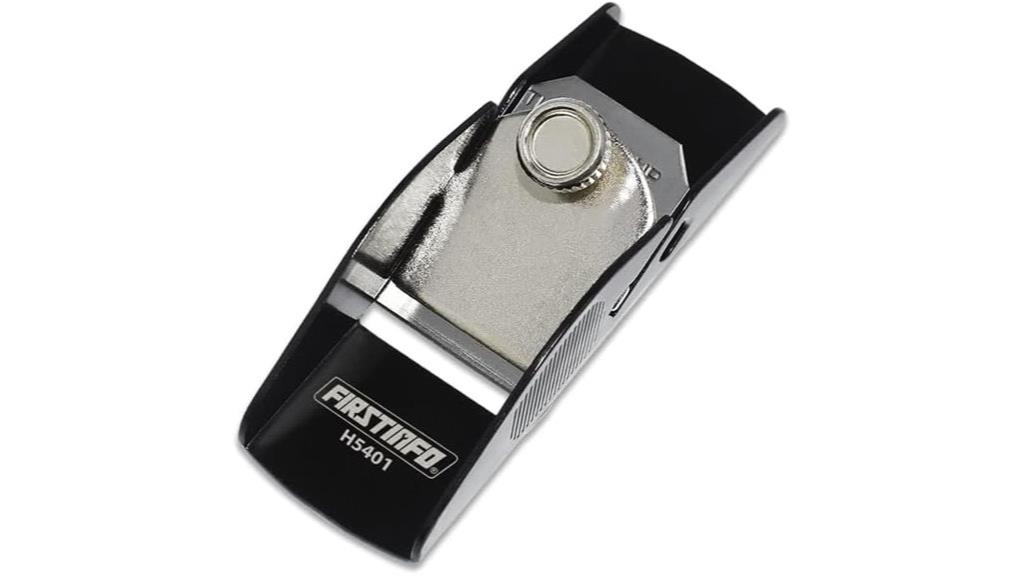
For those working on intricate woodworking projects or detailed model making, the FIRSTINFO H5401 Mini Hand Plane offers exceptional control in a compact size. Measuring just 3.38 inches long and weighing only 80 grams, it’s perfect for precise trimming and finishing tasks. Crafted with a durable alloy steel body and blade, it features an adjustable cutter screw for fine control. Its small, palm-sized design makes it easy to maneuver and store, ideal for soft woods and delicate work. While the adjustment can be fiddly at first, its portability and sharp blade make it a handy tool for both hobbyists and professionals tackling detailed tasks.
Best For: hobbyists, model makers, and DIY woodworkers seeking precise, small-scale trimming and finishing tools for delicate projects.
Pros:
- Compact, lightweight design for easy handling and portability
- Fully adjustable cutter screw for precise control over cutting depth
- Made with durable alloy steel, ensuring sharpness and longevity
Cons:
- Adjustment process can be fiddly and require some initial patience
- Flimsy frame may need firm pressure for effective use
- Red paint may wear off onto workpieces over time
Bench Dog No. 60-1/2 Block Plane for Trimming, Joinery & Fitting Doors

Designed for detailed trimming and precise joinery, the Bench Dog No. 60-1/2 Block Plane excels at fitting doors, drawers, and end grain work. Its low-angle design and adjustable mouth allow for fine control and minimal tearout. Made from durable cast iron and brass, it offers solid craftsmanship, with a hardened carbon steel blade for sharp, clean cuts. The compact size and lightweight build make it ideal for delicate tasks. While some users need to tune it for excellent flatness and blade alignment, many appreciate its precision, quality, and versatility. Overall, it’s a reliable tool for achieving tight fits and finished edges in woodworking projects.
Best For: woodworkers seeking a precise, low-angle block plane for detailed trimming, joinery, and fitting tasks in small or delicate projects.
Pros:
- Solid construction with durable cast iron and brass for long-lasting use
- Adjustable mouth and lateral blade controls for fine, precise cuts
- Compact, lightweight design ideal for detailed work and tight spaces
Cons:
- May require tuning and flattening to achieve optimal flatness and alignment
- Some users report difficulties sharpening or maintaining the blade steel quality
- Manufacturing inconsistencies can lead to uneven sole flatness and performance issues
Taytools Low Angle Block Plane with Knuckle Cap and Adjustment Screws
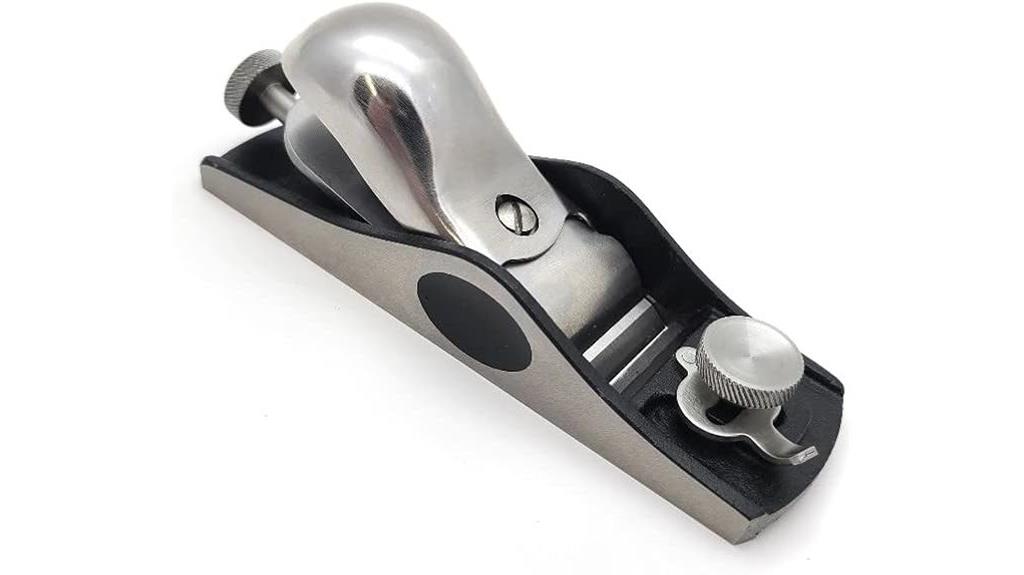
The Taytools Low Angle Block Plane with Knuckle Cap and Adjustment Screws stands out for woodworkers seeking precise control over small projects. Inspired by vintage Stanley designs, it’s perfect for smoothing and trimming end grain. Made from stress-relieved ductile cast iron, its durable construction guarantees longevity. The precision-lapped sole and hardened blade allow for smooth, accurate cuts. Features like the stainless steel knuckle cap double as a palm rest, and the adjustable mouth lets you fine-tune your work. Weighing just over 2 pounds, it’s easy to handle with one hand, making it ideal for detailed, delicate tasks.
Best For: DIY enthusiasts, cabinet makers, and woodworkers seeking precise control for smoothing and trimming small projects, especially on end grain.
Pros:
- Durable construction with stress-relieved ductile cast iron for longevity
- Precision-lapped sole and hardened blade for smooth, accurate cuts
- Adjustable mouth and blade for fine-tuning work and versatile use
Cons:
- Slightly heavier than some similar models, which may affect prolonged use
- Limited to hand-powered operation, requiring manual effort
- Might be less suitable for large-scale woodworking projects due to its size and design
Stanley 12-247 Block Plane
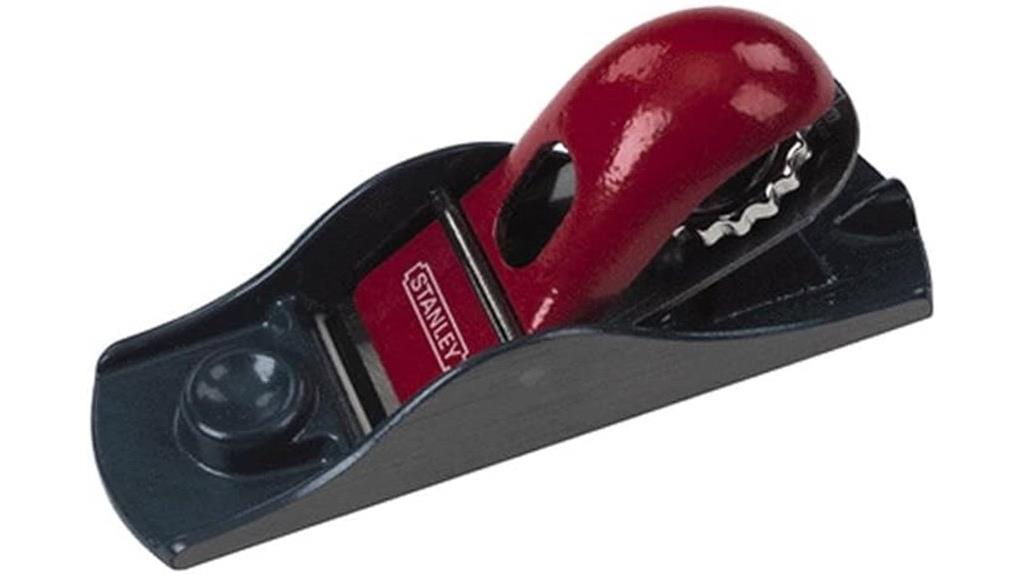
The Stanley 12-247 Block Plane stands out as an affordable, beginner-friendly tool perfect for light woodworking tasks. Made from tempered alloy steel with machined sides and a cast iron base, it offers durability and stability. Its 21-degree bevel makes it suitable for cross-grain planing, and the sharp blade can be set manually using a wheel and hammer taps. Weighing just about 1 pound, it’s easy to handle. While it lacks a traditional depth adjustment knob, skilled users can achieve fine shavings with patience. Ideal for trimming edges, removing saw marks, or small touch-ups, it’s a solid, budget-friendly choice for casual woodworkers.
Best For: casual woodworkers or beginners seeking an affordable, lightweight plane for minor touch-ups and light tasks.
Pros:
- Budget-friendly and easy to handle for beginners
- Sharp blade out of the box for immediate use
- Effective for small tasks like trimming edges and removing saw marks
Cons:
- Lacks a traditional depth adjustment knob, requiring manual tuning
- Blade can move during use, making precise control difficult
- Often needs sole flattening and blade sharpening for optimal performance
Spear & Jackson CJP5 Carpenters No.5 Jack Plane

If you’re looking for an affordable yet capable jack plane for rough timber preparation, the Spear & Jackson CJP5 Carpenters No.5 offers a solid option. Made with a cast iron body, it’s durable and stable, with a precision milled base for better control. The 2-inch high carbon steel blade provides effective cutting, though it often needs sharpening and setup adjustments. Weighing about 5 pounds, it’s lightweight enough to maneuver easily. While initial machining may be rough and the sole uneven, with some tuning—flattening, honing, and adjusting—it performs well, producing smooth shavings for rough shaping and prep work.
Best For: DIY woodworkers and carpenters seeking an affordable, customizable jack plane for rough timber preparation who are willing to invest time in setup and tuning.
Pros:
- Solid cast iron construction and durable build quality
- Produces smooth shavings once properly tuned
- Lightweight and easy to maneuver for a hand-powered tool
Cons:
- Initial machining is rough, requiring flattening and sanding of the sole
- Frequent sharpening needed for the blade to maintain effectiveness
- Adjustment mechanisms can have backlash and looseness, requiring patience to fine-tune
Big Horn 19322 6 Inch Adjustable Block Plane

For detailed woodworking tasks, the Big Horn 19322 6 Inch Adjustable Block Plane stands out with its precise blade adjustability and compact design. It’s perfect for fine trimming, smoothing end grains, and cross-grain planning. Made from impact-resistant cast iron with a durable epoxy coating, it offers long-lasting stability. The 1-5/8” high carbon steel blade, set at a 25° angle, minimizes vibrations and ensures smooth cuts. Easy adjustments via brass knobs and a quick-release cam-lock make workflow efficient. Its lightweight, compact size and included hardwood case make it ideal for small projects and detailed work, combining durability with precision.
Best For: woodworking enthusiasts and professionals seeking precise, durable, and versatile hand tools for detailed trimming, smoothing, and planning tasks on small projects.
Pros:
- Made from impact-resistant cast iron with a durable epoxy coating for long-lasting stability
- Precise blade adjustability with brass knobs and quick-release cam-lock for efficient workflow
- Compact and lightweight design with a hardwood storage case, ideal for detailed work and small projects
Cons:
- Limited to small-scale woodworking tasks due to its size and design
- Requires regular sharpening of the high carbon steel blade for optimal performance
- May have a learning curve for users unfamiliar with low-angle block planes
Factors to Consider When Choosing a Block Plane

When selecting a block plane, I focus on blade sharpness and quality to guarantee clean cuts, along with adjustability for precise control. I also consider size and portability to match my projects, plus material durability for longevity. Ultimately, I weigh price and value to find a tool that fits my budget without sacrificing performance.
Blade Sharpness and Quality
A sharp, high-quality blade is essential for achieving clean cuts and reducing the effort needed during planing. Premium blades made from steels like O1, high-carbon steel, or tool steels with hardness above Rc60 maintain their edge longer and sharpen more easily. This consistency in sharpness directly impacts the smoothness of the surface and the control you have over your work. Dull or soft blades tend to tear the wood, create rough surfaces, and require frequent re-sharpening or replacement, which can slow down your workflow. Choosing a plane with a high-quality, easily maintainable blade ensures superior performance and longevity. Ultimately, a well-made, sharp blade helps you achieve professional results with less effort and frustration.
Adjustability and Control
Adjustability and control are essential factors that determine how precisely you can shape your work with a block plane. A good block plane features mechanisms—like thumb screws, knobs, or wheels—that allow for fine-tuning the blade depth. This control lets you choose the right shaving thickness for different tasks, from rough stock removal to delicate finishing. The ability to adjust the mouth opening enhances performance across various wood types and densities. Micro-adjustment features can help achieve smoother finishes and detailed work with greater consistency. The range of adjustment varies, with some models offering coarse settings and others providing fine-tuning options. Reliable, smooth mechanisms minimize backlash, giving you consistent control and confidence during your woodworking projects.
Size and Portability
Choosing the right size and portability for a block plane depends on the tasks you’ll tackle and how you plan to use it. Smaller models, typically around 3.5 inches, are lightweight and easy to carry, perfect for detailed work or working in tight spaces. They’re highly portable, fitting easily into pockets or toolkits. Larger planes, over 9 inches, provide better stability and leverage, making cutting more efficient but less maneuverable for delicate tasks. Your choice also affects storage; compact planes are convenient to store and transport, while larger ones may need dedicated space. Consider weight, overall size, and ergonomic features like handles to match your work style. Balancing size and portability ensures you’ll have the right tool for both precision and convenience.
Material Durability
The durability of a block plane heavily depends on the materials used in its construction, influencing how well it withstands everyday woodworking demands. A body made from cast iron, ductile iron, or aluminum offers resistance to wear and damage, ensuring longevity. High-quality steels like O1 or high-carbon steel for blades maintain sharpness longer and resist chipping, which is essential for precise cuts. Corrosion-resistant materials, such as stainless steel or coated surfaces, help prevent rust and extend the tool’s lifespan. Additionally, the choice of materials affects the plane’s weight and balance, making it easier to handle and reducing fatigue during extended use. Durable construction materials also help keep the sole flat and properly aligned, ensuring consistent, accurate results over time.
Price and Value
Price and value are key factors to contemplate when selecting a block plane, as they directly impact your overall satisfaction and long-term investment. Basic models can cost under $20 but often need additional tuning to perform well. On the other hand, high-end options over $100 typically feature better materials, precision machining, and longer-lasting blades, which can save you money over time. The true worth of a block plane depends on its durability, performance, and how well it suits your woodworking needs. Sometimes, spending a bit more upfront yields greater satisfaction with fewer upgrades or replacements down the line. Balancing cost with quality ensures you get a tool that offers both reliable performance and lasting value, making your woodworking experience more enjoyable and efficient.
Ease of Tuning
When selecting a block plane, how easily it can be tuned often makes a big difference in your woodworking experience. A well-designed plane features simple, accessible adjustment mechanisms like clearly marked knobs or screws, allowing precise blade positioning without much effort. Smooth-acting controls help you make quick, accurate adjustments, saving time and frustration. Conversely, planes with backlash or play in the adjustment system can make fine-tuning difficult and slow. Properly machined soles and frog assemblies also contribute to easier tuning by reducing the need for extensive flattening or realignment. Additionally, adjustable mouth openings that can be easily set and locked without tools make switching between tasks hassle-free. Overall, a plane that’s easy to tune helps maintain precision and keeps your workflow smooth.
Frequently Asked Questions
Which Block Plane Is Best for Detailed Fine-Tuning Tasks?
When it comes to detailed fine-tuning tasks, I recommend a block plane with a low angle and a sharp blade. I find that a #62 or #60 1/2 block plane works perfectly because of their precision and ease of control. These planes allow me to make very fine adjustments, especially on end grain or tricky areas, giving me the accuracy I need for my woodworking projects.
How Does Blade Material Affect Plane Performance?
When considering how blade material affects plane performance, I find it’s vital because it impacts sharpness, durability, and ease of honing. High-quality steels like high-carbon or tool steel stay sharper longer, making precise cuts easier and reducing maintenance. I prefer blades that balance hardness with toughness, ensuring longevity without chipping. Ultimately, choosing the right blade material enhances my control and results, especially when working on detailed, fine-tuned woodworking projects.
What Safety Features Are Essential in a Block Plane?
When choosing a block plane, I believe safety features are essential. I always look for a blade guard to prevent accidental cuts and a secure locking mechanism to keep the blade stable during use. Non-slip grip handles also help me control the tool safely. These features give me confidence and reduce risks, making my woodworking safer and more enjoyable. Safety should always come first with any power or hand tool.
Can a Block Plane Be Used for Metalworking?
You might think a block plane is only for wood, but I’ve actually used mine for light metalwork! While not designed for metals, I’ve found that with a super fine blade and careful handling, it can tackle soft metals like aluminum or brass. Just remember, it’s not a dedicated metal tool, so don’t push your luck—stick to softer metals and use it carefully for best results.
How Does Adjusting the Mouth Influence Cut Quality?
Adjusting the mouth of a block plane really impacts the cut quality. When I open the mouth wider, it’s great for removing rough material or working on softer woods, but it can cause tear-out. Narrowing it tightens the cut, giving me a smoother, more precise finish. I always tweak the mouth based on the task, and it makes a noticeable difference in the surface quality I achieve.
Conclusion
When choosing the perfect block plane, focus on precision, comfort, and versatility. Prioritize tools that provide smooth cuts, easy adjustments, and reliable durability. Consider your specific projects, your skill level, and your budget. Because a good block plane enhances your craftsmanship, simplifies your tasks, and elevates your results. Invest wisely, select thoughtfully, and enjoy the process of creating with tools that truly serve your woodworking needs.
